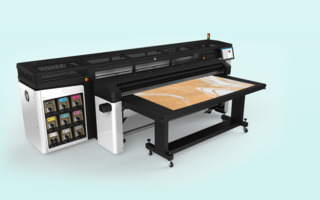Why White Ink is an Irreplaceable Tool for PSPs
A printing industry novice might assume that printing without white ink is no different than printing with it—this isn't the case.

If you’re new to the print industry, you may not understand the significance of white ink. In fact, you might assume that printing with white ink makes little difference than printing without it—this is not the case.
When white ink is working at its full capacity, it provides numerous benefits to Print Service Providers (PSPs), such as vibrant images and endless printing applications unattainable with a CMYK gamut alone. Printing News spoke to leading industry experts about what makes white ink a pertinent tool for any PSP or customer.
White Ink Normalizes the Surface of Dark Substrates
Without a foundational layer of white ink on a dark colored substrate of any kind, color would simply fail to be seen with any degree of brilliancy, according to each industry expert Printing News spoke with.
“It’s pretty simple, white ink allows you to print on paper, or substrates and material that are not white,” said HP’s Chief Inkologist, Thom Brown.
Applying an opaque base layer of white ink prior to applying colored ink mimics the look of printing on a white substrate, according to Matt McCausland, Product Manager of Professional Imaging at Epson America.
“If PSPs were to print directly on to a dark substrate without a white ink base layer the color output would be dull, muted, and unrecognizable,” said McCausland. If they opted out of using white ink, PSPs would have to resort to using white or light colored substrates to get their desired colors.
Brian Dollard, Director of Strategic Planning and Business Development for Ricoh USA, provided an apt example of how white ink can be utilized on a dark surface: “Generally speaking, whether it’s white ink or white toner—and we do both here at Ricoh—it’s all about normalizing the surface that you’re printing on. If you go to a concert or a motorcycle shop, most oft en the t-shirts there are black, right? And we want to be able to print vibrant colors on that [black] t-shirt because it’s a background that’s enjoyable to that audience. We can’t print with the inks and the toners that we use normally—especially the inks—because they don’t have the capacity to cancel out that surface and the background that you’re printing on.”
Substrate Applications are Limitless
The applications for white ink are seemingly limitless. There are multiple materials that can now be printed with white ink, that include clear glass, plastic, and even wood according to Brown.
“We’re now printing on substrates that years ago we never even dreamed we could print on,” said Dollard. “I mean, who thought we’d be printing on glass, on stone, on wood, and on three-dimensional objects? At SGIA last year, we were printing on cinder blocks.”
White Ink is Essential for Textile, Special Effects, and Signage Printing
Textile printing is one of white inks’ most popular applications. Without white ink, textile printers must resort to printing solely on white or light-colored garments.
“For textile printing, most customers use a white textile material (some type of soft fabric), so in most cases, the white ink is not needed as much for this type of application,” explained Kaz Kudo, Associate Product Manager of FUJIFILM North America’s Graphic Systems Division. “The more important thing is for the material to have the best white possible.”
Another important use of White Ink is to create the base for printing special effects, like metallics. White Ink acts as a barrier so that metallic effects don’t come through the CMYK image in unwanted areas, according to Kudo. White ink has become especially important in the label and packaging industry, as its use is essential when printing on clear and metallic substrates. A larger gamut is needed to print on metallic substrates and the average printing system is usually limited to four to seven inks, according to Mike Pruitt, Product Manager of SurePress at Epson America.
“White ink is required for clear and metallic substrates,” explained Pruitt. “In the case of the labels and packaging industry, white ink is a very strong and growing percentage of the market, especially in the premium market. In addition, having white ink that is opaque is very important in the selection of the press. Other factors such as adhesion of ink to substrates, and the capability of the ink system to reliably handle the more viscous and sedimentary nature of the white ink.”
The ability to print white ink on clear substrates has also proved to be of great importance in the signage industry, as window clings and clear backed stickers frequently utilize the ink, according to McCausland. (He additionally noted that white ink can add new dimension to backlit prints.)
The Future of White Ink
White ink’s presence in the printing industry is growing as white ink technology evolves and becomes even more important in the production of bright, vibrant printed materials.
But white Ink can be finicky and difficult to use. It can pose troublesome issues including drying with a yellowish tint, going bad from being used inconsistently, and lacking the opacity needed to make other colors pop.
HP’s new white latex ink is looking to eradicate these issues. Upon announcing HP’s new rigid latex printing technology in March, it was also announced that HP would be delivering an innovative, glossy, high-quality “true white” that avoids yellowing over time like traditional UV-based white ink.
“White ink has been a consistent problem for the industry. Traditionally, it uses bigger and heavier pigment particles that frequently clog printheads, or the opaque mixture becomes separated and settles to the bottom of the ink reservoir. Until now, physically shaking the reservoirs often has been the necessary solution,” said Brown. “Through HP’s investment in innovation around chemistry and engineering, the white ink solution with the HP Latex R Series is an industry breakthrough.”





















